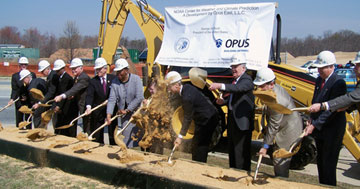UNIVERSITIES AND ECONOMIC DEVELOPMENT
Who Walks the Talk?
| T |
hink regional economic development is a collaborative challenge? Many would say it pales in comparison to collaboration within the politically charged
 |
| The new $50-million NOAA Center for Weather and Climate Prediction will be the "crown jewel" of a new section of the University of Maryland's M-Square Research and Technology Park. |
 |
But natural university connections with economic development agencies far and wide are the most natural form of town-gown outreach, often taking concrete form in incubators and business parks on university-held land. It may even bring together university departments.
"How do you take the innovation coming out of the universities?" site consultant Gene DePrez, head of IBM Global Location Strategies, asked the audience at a recent legislative summit presented by the International Economic Development Council in Washington, D.C. His firm is working with Rick Tuttle and the Research Triangle Park in North Carolina on answering just that question, and he says such work could carry "far greater leverage in terms of retaining and growing jobs than tax incentives."
The power of that leverage was evident in an idea floated in February 2006 by EU President José Manuel Barroso, who said what the EU needs to do is create a "European MIT."
Education was central to several discussions at the IEDC Summit. Phyllis Eisen, the appropriately outspoken spokesperson for the National Association of Manufacturers, said a new survey revealed that 31 percent of respondents go to community colleges for external resources, but only 16 percent go to universities. She pointed to a pilot project to promote manufacturing in the Kansas City area that has already stoked a 35-percent increase in enrollment in manufacturing-related courses at the local business and technology college. No reason the universities shouldn't play as well.
In fact, one of the organizations that has stoked the momentum in Kansas City – The Kauffman Foundation – has pointed the finger at universities to do more. In advance of a September 2005 conference on "Advancing Innovation and Entrepreneurship," the foundation said two years of research indicated that university-related innovation is too slow to reach the market, if it reaches it at all.
"Discoveries and inventions that could lead to new therapeutic drugs, new medical devices and other life-saving or life-enhancing technologies are either being overlooked in university laboratories or, in other cases, languishing in a system that is intended to move them into practical use, but is instead inhibiting their success," said Lesa Mitchell, vice president of Advancing Innovation at the Kauffman Foundation. Among signs of the underperformance:
• Some elite institutions' innovation output is not nearly commensurate with their research funding.
• Innovation activity tends to revolve around the patent-license model, thereby placing the burden within the university's largely understaffed technology transfer office. Few universities understand that innovations can move through multiple pathways, requiring coordination of various activities across a university.
• Private sector firms and investors trying to license university innovations report that their efforts are often hindered by bureaucratic delays and the lack of efficient and effective cultures, practices and/or expertise within the universities.
Emily Stover DeRocco, assistant secretary, U.S. Dept. of Labor, tells Site Selection, "When I entered this job, the universities were nowhere at our table. The college and university system did not see work force development as a relationship with the publicly funded work force system. And the system did not understand its role. Now 90 percent of the fastest-growing jobs require post-secondary education, and only 34 percent of population has that college degree."
Thus, says DeRocco, "We have slowly but surely been bringing them to the table, as a full partner in the continuum of education from K through gray. But also the continuum of innovation usually begins in a university facility, research park or lab. It then spins out to a commercially available product or service. At each step in that continuum, there is a need for support. So the universities have substantial roles in driving the innovation – and often driving the regional strategic vision – as well as being a key player in developing talent."
But the role of private industry in education needs to grow as well, and not just at the higher levels.
"At a minimum you have to get to them before they've made that decision to get out of high school," said Dr. Robert Leber, director, education and workforce development, Northrop Grumman Corp. at the IEDC Summit. "The business community needs to be in the middle schools and high schools, not just talking about their company, but through Junior Achievement and so on. Eventually everybody goes into the work force … the business community needs to do some evangelizing."

